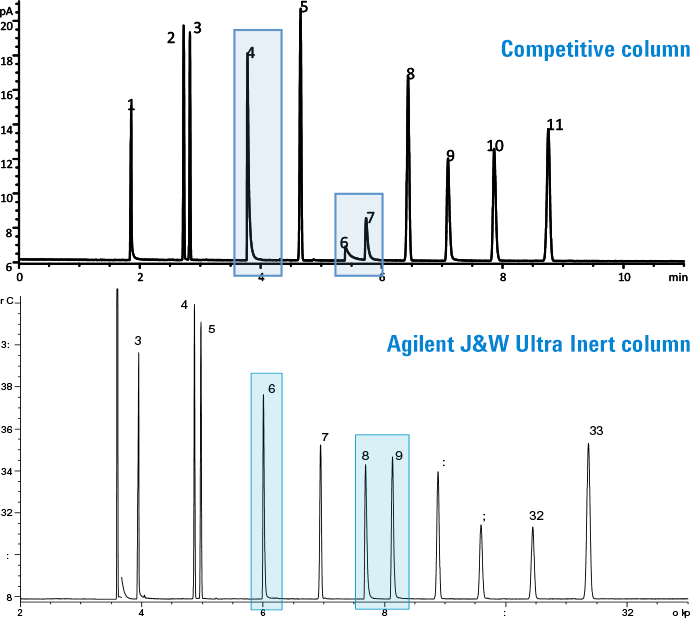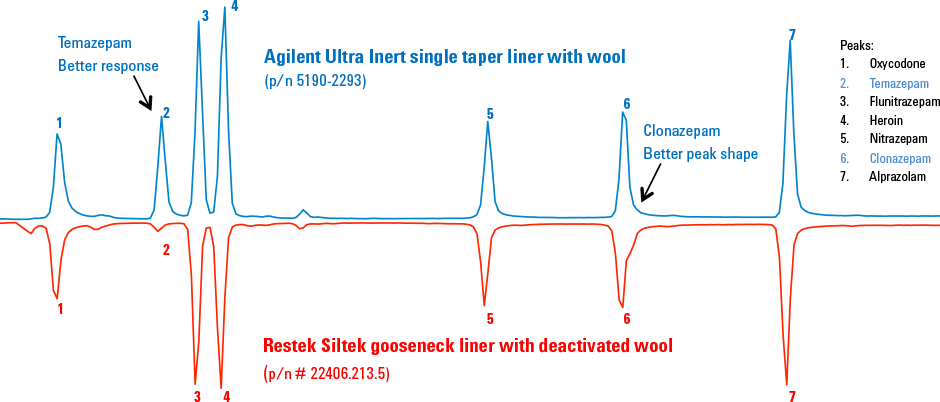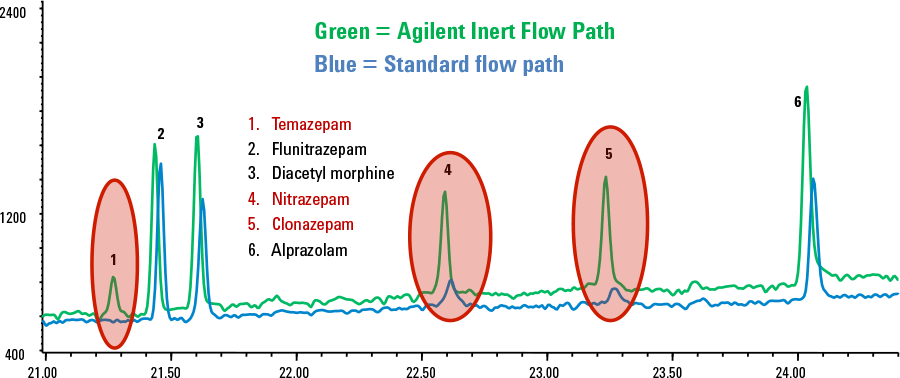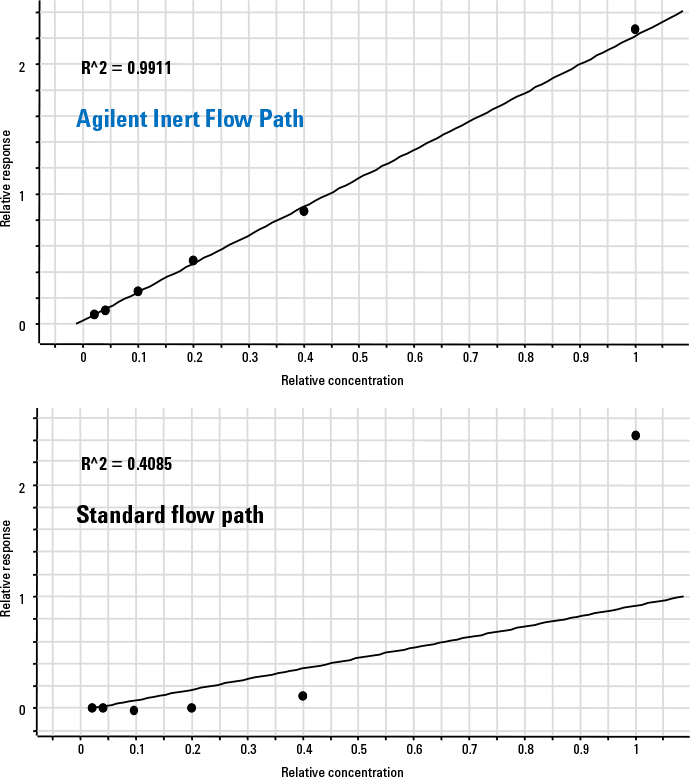Access Agilent eNewsletter February 2016

Agilent Inert Flow Path for GC and GC/MS minimizes surface activity that compromises your results
Abby Folk and Xiaomi Xu
Agilent Product Managers
Limian Zhao and Ken Lynam
Agilent R&D/Applications Chemists
GC and GC/MS detector technology now pushes the limits of detection to parts-per-billion and parts-per-trillion levels. But detectors can detect only the analytes that reach them, which makes even the most sensitive detector at risk to the GC sample flow path. Within this flow path, active sites on the surface can adsorb or catalytically decompose labile analytes. This surface activity can cause peak tailing, signal loss, and false negative reports. To overcome these serious barriers, Agilent provides GC components that ensure inertness throughout the entire sample flow path.
GC flow path components for improved inertness and performance
Sample residence or contact time and surface area are the major contributors to activity in the GC flow path. GC columns and inlet liners contribute more than 90 percent of contact surface after sample is injected. These components have been the focus of recent Agilent developments that improve system inertness and add to system performance.
In addition to the GC column and liner, other flow path components that the sample may contact include:
- Inlet gold seal
- Inlet weldment parts
- Metal ferrules
- Capillary flow technology (CFT) devices
- Detector components
These parts in the flow path are metal, and hot metal surfaces can produce degradation or adsorption of active analytes. Agilent employs passivation techniques to block the active sites on each.

Figure 1. GC column activity: Column test mix demonstrates that an Agilent Ultra Inert column delivers superior peak shapes for challenging compounds.

Figure 2. Inlet liner activity: Agilent Ultra Inert liner provides better response and peak shape for drugs of abuse that are difficult to chromatograph.
Achieve outstanding results with deactivated glass and metal
Agilent uses two proprietary deactivation chemistries to minimize activity on glass or metal in the flow path.
- Ultra Inert chemical deactivation improves inertness of GC columns and liners. With modification, the Ultra Inert process is applied on top of the gold plating used on inlet seals.
- UltiMetal Plus deactivation is suitable for stainless steel surfaces. It is applied to the remaining metal components in the flow path.
We evaluated inertness of the entire GC flow path by adapting procedures used successfully to test GC columns (Figure 1) and liners (Figure 2).
For other parts in the flow path, we developed protocols that used trace levels of the same labile compounds. We compared passivated and standard components, while keeping all other test conditions constant. Because contact time with these components is short, methodology to evaluate inertness of individual constituents was challenging; at times, we developed methods to increase exposure to active sites.
Reliable analyses with deactivated seals and ferrules
Even seemingly minor flow path components like seals and ferrules can degrade analyses when they have active surfaces. For example, we compared peak shapes of organophosphorus pesticides when exposed to a standard gold plated seal, a passivated stainless steel seal, and the Agilent Ultra Inert gold plated seal. The Ultra Inert gold seal gave better recovery of active pesticides like acephate and omethoate.
For samples in a heavy nonvolatile matrix, Agilent modules that employ Capillary Flow Technology offer backflush capability. Our studies showed that Agilent deactivated metal ferrules used for backflush plumbing delivered significantly better recoveries of active pesticides like acephate, omethoate, and demeton-S.

Figure 3. Agilent Inert Flow Path delivers significantly better responses for difficult drugs of abuse analyzed in SIM mode at the 0.25 ng level on-column.

Figure 4. Calibration curves for acephate at six concentrations demonstrate dramatic improvement in linearity with the Agilent Inert Flow Path.
Complete Agilent Inert Flow Path provides better peak responses and linear calibration curves
After qualification of individual components, we assembled the passivated parts into an entire Agilent Inert Flow Path. We then injected drugs of abuse samples into inlets comprised of either Inert Flow Path or standard flow path components. Figure 3 compares selected ion monitoring (SIM) chromatograms analyzed on each flow path.
The improvements in response and peak shape for active analytes directly impact calibration curve linearity, as shown in Figure 4. We generated these calibration curves for this active pesticide over a range of 10 to 500 ng/mL, and the Inert Flow Path produced exceptional linearity at low levels.
Uncompromised results for difficult active analytes
Passivated GC components deliver:
- Lower detection limits, with increased response and better precision
- Improved peak shape for better resolution and peak integration, especially at low levels
- Better response per unit concentration, which means more injections before system maintenance is required
To achieve detection at the parts-per-billion and parts-per-trillion levels offered by the latest GC and GC/MS detector technology, ensure that active analytes reach your detector. If you struggle with active sample compounds and want to improve sensitivity, reduce peak tailing, and achieve better productivity with less troubleshooting, discover more about Agilent Inert Flow Path solutions today.
Stay informed about the applications that are important to you
Subscribe to Access Agilent
Our free customized
monthly eNewsletter
Article Directory – February 2016
All articles in this issue
 New Agilent AdvanceBio SEC column simplifies mAb/ADC analysis
New Agilent AdvanceBio SEC column simplifies mAb/ADC analysis Support sustainability and maximize value for your labs by selling or buying used instrumentation
Support sustainability and maximize value for your labs by selling or buying used instrumentation Ask the Expert: Where can I go for expert advice on dissolution issues and techniques?
Ask the Expert: Where can I go for expert advice on dissolution issues and techniques? Agilent GC/MS/MS enables trace level analysis of dioxins in environmental samples
Agilent GC/MS/MS enables trace level analysis of dioxins in environmental samples Agilent Inert Flow Path for GC and GC/MS minimizes surface activity that compromises your results
Agilent Inert Flow Path for GC and GC/MS minimizes surface activity that compromises your results Tip: One call to Agilent ensures optimal performance of your PerkinElmer systems
Tip: One call to Agilent ensures optimal performance of your PerkinElmer systems Agilent AdvanceBio Peptide Mapping columns to solve glycan mapping challenges
Agilent AdvanceBio Peptide Mapping columns to solve glycan mapping challenges Agilent supports GC/MS with fast, accurate FTIR screening of phthalates in toys
Agilent supports GC/MS with fast, accurate FTIR screening of phthalates in toys Reduce carryover and enhance analysis speed with new Agilent 1290 Infinity II Vialsampler
Reduce carryover and enhance analysis speed with new Agilent 1290 Infinity II Vialsampler
Figure 1

- 1-Propionic acid
- 1-Octene
- n-Octane
- 4-Picoline
- n-Nonane
- Trimethyl phosphate
- 1,2-Pentanediol
- n-Propylbenzene
- 1-Heptanol
- 3-Octanone
- n-Decane
GC column activity: Column test mix demonstrates that an Agilent Ultra Inert column delivers superior peak shapes for challenging compounds.
Figure 2

Inlet liner activity: Agilent Ultra Inert liner provides better response and peak shape for drugs of abuse that are difficult to chromatograph.
Figure 3

Agilent Inert Flow Path delivers significantly better responses for difficult drugs of abuse analyzed in SIM mode at the 0.25 ng level on-column.
Figure 4

Calibration curves for acephate at six concentrations demonstrate dramatic improvement in linearity with the Agilent Inert Flow Path.